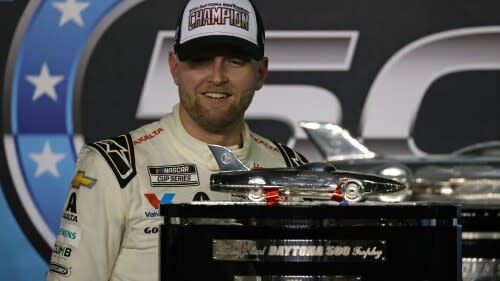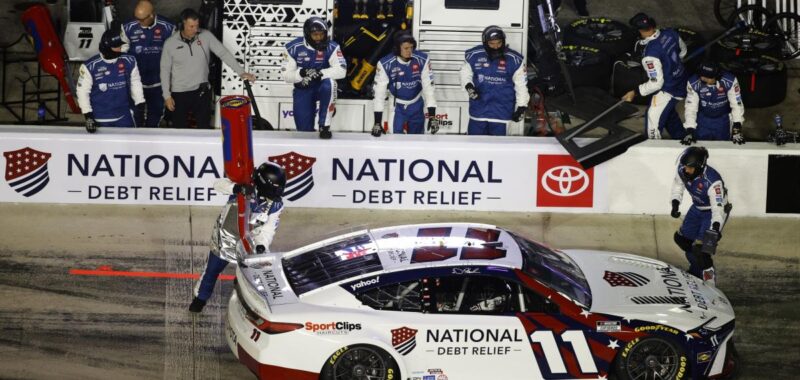DAYTONA BEACH, Fla. —Thursday’s qualifying races created a buzz in the NASCAR Cup garage by what one organization did to shave time on pit road, which could impact Sunday’s Daytona 500.
The Joe Gibbs Racing pit crews of Denny Hamlin and Ty Gibbs debuted a unique way to alert their drivers when to leave on a fuel-only pit stop.
During the fuel-only stop for both on Thursday at Daytona International Speedway, two crew members went over the pit wall — the fueler and a crew member who held a tablet near the front windshield for the driver to see.


NASCAR looking at possibility of moving the Clash outside the U.S. in the future
The Clash was at Bowman Gray Stadium in Winston-Salem, North Carolina, this year.
Needing only a few seconds of fuel, the JGR teams set the tablet to do a countdown before going to an all-green screen that signaled for the driver to leave.
“It looks really cool,” said defending Daytona 500 winner William Byron. “So, you know, it’s a copycat sport, right? I’m sure you’ll see more of it, if it works well. Right now for us, I think we’ve got a good system, but who knows?”
Here is a look at that system:
We saw that pit crew members from @JoeGibbsRacing had tablets that would light up in green as a car reached its fuel fill target to tell the driver and fueler that the car can take off.
Let’s dig into how this works and how they choose the time when it should change colors. pic.twitter.com/6z2hlQGUy9
— Bozi Tatarevic (@BoziTatarevic) February 14, 2025
Said John Hunter Nemechek of the JGR tablet system: “The first time I saw it was on the broadcast … I was like dang, that is pretty neat. That is pretty cool.”
Nemechek said he expects “almost every team look into (it) now that it is out there. Who does it on Sunday, or who tries again on Sunday? I’m not sure, but it’s not bulletproof yet, I would say.”
Multiple drivers told NBC Sports that they sent a video clip of the JGR pit stops using the tablet system to their crew chiefs to consider for the future.


With memories, with family, Dale Earnhardt Jr. makes new journey to Daytona 500
Dale Earnhardt Jr. will experience his first Daytona 500 as a NASCAR Cup car owner on Sunday.
It’s not likely any teams will change their system for Sunday’s Daytona 500 because they won’t want to try something new in the sport’s biggest race. So, if the tablet system is used, it could be only by Joe Gibbs Racing pit crews.
Here is why this system could be a factor in the 500: Fuel saving is critical at Daytona and Talladega with their drafting style of racing. Drivers who are deeper in a pack of cars don’t use as much fuel, so when they pit they don’t need as much fuel as the leader, who burns more because they don’t have the advance of an aerodynamic draft.


How to watch Sunday’s Daytona 500: Start time, TV info and weather (UPDATED)
It’s the 67th running of The Great American Race.
Also, since the cars don’t carry enough fuel to make it to the end of the the stages at Daytona, they must pit for fuel. During green-flag stops, teams will only add enough fuel to make it to the end of the stage in the first two stages. They can refill and change tires then during the stage break under caution.
Less time on pit road can help a car leapfrog those ahead. If they can get to the front, they can control the race.
Brian Campe, technical director of Legacy Motor Club, noted that in the second qualifying race Thursday, the difference between the cars in first and 20th before they pitted was 1.3 seconds.
“If I can shorten my time in the stall and get it exactly right, then that’s a big gain in positions,” Campe said. “Every half a second in the stall or even two tenths of a second (saved), that’s a quarter of the way up the field from 20th.”


Several former Stewart-Haas Racing members find work in NASCAR Cup Series
A look at where many Stewart-Haas Racing teams members moved to after the team closed shop after last year.
So what makes the tablet system potentially faster?
Typically on a fuel-only stop, the fueler will nod their head when they’ve filled the fuel cell, signaling to the crew chief to radio the driver to go.
“If you think about the sequence of the fueler plugging in, to the fueler seeing it in the tube (that signifies the cell is full), to moving his head to the crew chief pushing the button, we can easily find probably three quarters or even sometimes a second there,” Campe said.
“If that’s the case, if we can do that on an iPad and simply say, ‘OK, the fuel is plugged in and start,’ then the driver can react to what he is seeing a lot faster than that sequence (currently used by all the other teams).”
This isn’t the first time Joe Gibbs Racing pit crews have tried something unique to cut time on pit road. In 2022, JGR debuted a new pit stop designed to be quicker.
What was different with the stop was that the rear tire changer went around the front of the car to reach the right rear tire. Once complete, that person went back around the front of the car and changed the left front tire. The crew member who changed the right front went around the front of the car to the right rear.
The pit stop was quicker than the traditional way of the right front tire changer also going over to change the left front tire. But the problem with the JGR pit stop was that any hiccup with it made the stop significantly slower.
A year after Joe Gibbs Racing debuted that pit stop style, the organization abandoned it because too often the crews didn’t run it well enough and lost track position.

